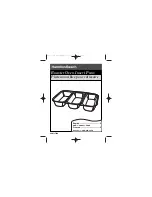
Some women worry that if they improve the brain’s development the baby’s
head will be larger, thereby causing an increase in the risk of delivery
problems. In fact, there is reason to believe the opposite is true. Prenatal
sound stimulation has led to shorter and less painful labor periods, a lower
number of Cesarean section deliveries, and a greater number of non-traumatic
births.
6
In addition, a baby who experiences prenatal stimulation
tends to:
•
Be calmer and more alert
•
Be happier and cry less
•
Have a longer attention span
•
Be stronger and have better coordination
•
Lift his or her head up earlier and stand earlier
•
Walk earlier
•
Talk earlier
•
Have more self-confidence
7
INSTRUCTIONS (You will need your own CD/Cassette player)
Remember, by the end of the fifth month your unborn baby begins to hear,
and by the sixth month her ability to learn increases significantly. It is now
time to start stimulating your baby. Keep in mind that your baby is most
alert during the evening hours so you may want to play music or talk to
her a few more times. But remember, she also has to rest.
The Prenatal Gift Set is a Personal Care Product
and cannot be returned to the retailer. All exchange and refund
requests should be directed to our Help Desk.
If you are having difficulty, have questions, or
need assistance, call our Help Desk toll free at
1-888-232-6476 Mon-Fri from 9:00AM-5:000PM EST
To Play Music to Your Unborn Baby (Please refer to diagrams on
P. 20-22)
The best time to play the music is once in the morning and once in the
evening, for a period of 5-10 minutes, around the same time each day. Be
careful not to play the music too long or too frequently, as your unborn baby
also needs to rest. However, you will probably find that your baby will be
very active and obviously awake during the evening.
Do not play the same music over and over again. It is believed that if your
baby hears the same thing repeatedly, she will eventually ignore it. However,
periodic repetition of the same music is advisable. In some cases when the
music was played after the baby was born, the newborn seemed to recognize
the melody.
Therefore, we suggest playing different music during each session in a single
day, and replaying it two or three days later. We also suggest that you keep
a schedule for the music you have played showing the date, music played,
and times it was played. (We’ve provided you with a starter schedule on
P.23 in this booklet.)
Now, simply follow these easy steps. (See diagrams P.20-22)
1. Connect the cable from the Fetal Speakers to your own CD/Cassette
player. Use the adapter if you want to listen to the music at the same
time.
2. Insert the enclosed CD or cassette of classical music.
3. Position the speakers against your belly. You will want to adjust the
position of the speakers depending on what month of your pregnancy
you are in. You should be able to tell where your baby’s head is by
where you feel her kicking most frequently. You may tuck the speakers
into your clothing or use the BébéSounds
®
maternity belt to hold them
in place.
4. Play the music for approximately 10 minutes at a time and alternate the
selections you play. Use the schedule included in this booklet as a record
of what selections you have played and how frequently you played them.
17
16










































